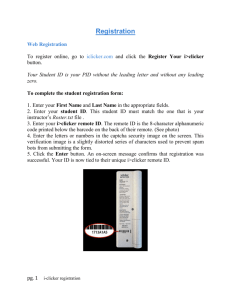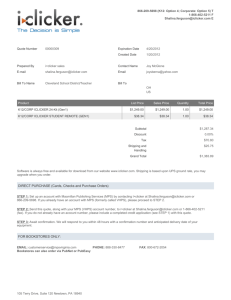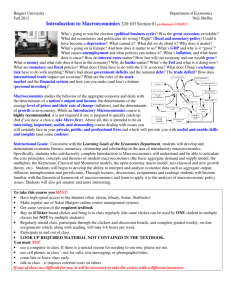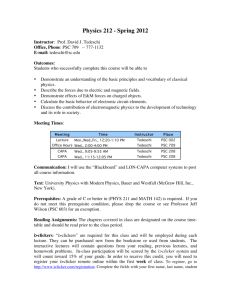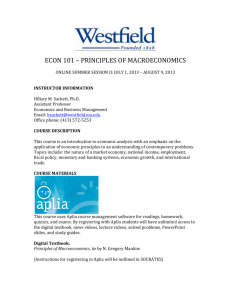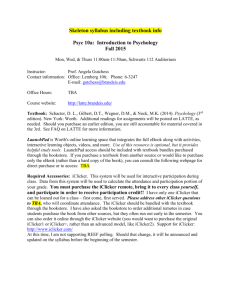Economics 303 Syllabus Intermediate Macroeconomics Section 3
advertisement
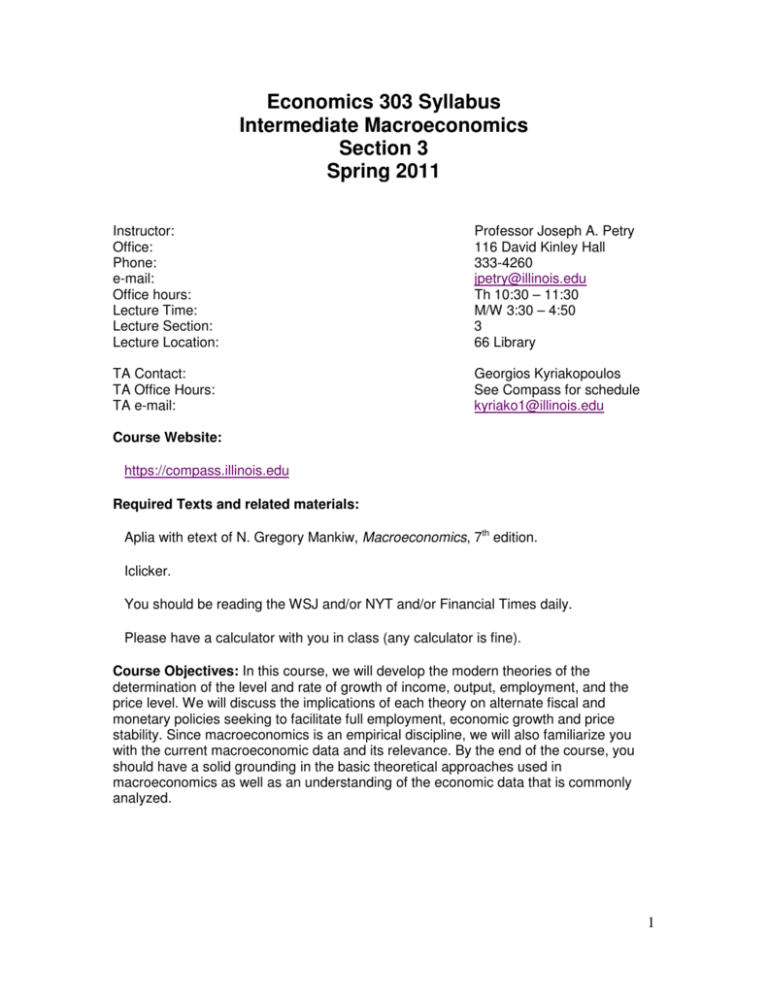
Economics 303 Syllabus Intermediate Macroeconomics Section 3 Spring 2011 Instructor: Office: Phone: e-mail: Office hours: Lecture Time: Lecture Section: Lecture Location: Professor Joseph A. Petry 116 David Kinley Hall 333-4260 jpetry@illinois.edu Th 10:30 – 11:30 M/W 3:30 – 4:50 3 66 Library TA Contact: TA Office Hours: TA e-mail: Georgios Kyriakopoulos See Compass for schedule kyriako1@illinois.edu Course Website: https://compass.illinois.edu Required Texts and related materials: Aplia with etext of N. Gregory Mankiw, Macroeconomics, 7th edition. Iclicker. You should be reading the WSJ and/or NYT and/or Financial Times daily. Please have a calculator with you in class (any calculator is fine). Course Objectives: In this course, we will develop the modern theories of the determination of the level and rate of growth of income, output, employment, and the price level. We will discuss the implications of each theory on alternate fiscal and monetary policies seeking to facilitate full employment, economic growth and price stability. Since macroeconomics is an empirical discipline, we will also familiarize you with the current macroeconomic data and its relevance. By the end of the course, you should have a solid grounding in the basic theoretical approaches used in macroeconomics as well as an understanding of the economic data that is commonly analyzed. 1 Course Grade: Mid-term I Mid-term II Final Exam Homework Paper Class Participation 20% 20% 30% 15% 10% 5% Grading Scale: The scale used to assign letter grades in the course will be established by the instructor at the end of the semester. A "+/-" scale will be used. The cut-offs for letter grades and the "+/-" will also be established by the instructor at the end of the semester. Grades will be posted on the Gradebook feature within Compass: http://compass.illinois.edu/. Exams: There will be three exams (two mid-terms and a final) given during the semester. The mid-terms will be given during regularly scheduled class. The second mid-term will only cover the material after the first mid-term. The dates of the mid-terms will be determined during the semester. The final exam will be comprehensive and will be given from 1:30 – 4:30 on Thursday, May 12th. All students must bring their University Student ID with them to every exam. If you do not have your Student ID, you may not be given the exam. As a rule, we do not offer conflict exams. We follow the university guidelines pertaining to exceptions to this policy as stated in the Student Code. If you believe you are eligible for a conflict exam (including the final exam), you must notify Professor Petry and the TA in writing during the first week of class. If you do not notify Prof. Petry in a timely fashion, you may not be eligible for the conflict. Homework: Homework represents an important part of this course. Aplia will be the principal homework platform for this course. The average of your attempts will determine your homework score. If necessary, additional homework questions will be assigned, which will be turned in separately from Aplia. You will be assigned homework after each chapter. Due dates will be given as the assignments are made, though generally homework will be due the following Monday after it was assigned. No late homework will be accepted. Term Paper: There will be one paper during the semester. The purpose of the paper is to analyze the current economic condition of a country of your choosing. You should also provide recommendations for monetary and fiscal policy consistent with your analysis. You will address your paper to the FOMC or similar policymaking body appropriate to the country selected. While in reality, this body may be more focused on short term stabilization policy through monetary policy, you should address monetary, fiscal and growth policies both short-term and long-term in nature. The paper should be comprised of two sections. The first will be the written portion and should be between 10-15 pages in length, double-spaced. You should provide a summary of your analysis and recommendations, followed by a description of the current economic conditions of the country, and then your policy recommendations. The second part of the paper is the data that you compile to clarify and deepen your understanding of the current economic 2 situation. This will serve as the appendix to the paper and should include at least 8 but no more than 16 well done graphs of current economic indicators of your choosing. The data selected, the time frame, and measurement used (e.g. year-over-year percentage change, seasonally adjusted annualized rate) should be made so as to maximize the insight brought to bear by that indicator. Graphs intended to depict the current macroeconomic situation must include the most recent data available. The analysis of economic conditions should tie closely to the graphs. It is preferable that these graphs be formatted consistently, and printed 4 to a page. While you must write the paper yourself, you should discuss your thoughts with others in the class, and you may create graphs that may be shared between you. This is to encourage a higher quality of work. Sample papers from a previous semester are available on the website. You are encouraged to meet with the TA to discuss specific questions you might have as you draft your paper. The term paper is due no later than 3:30 Wednesday, April 27th. It must be turned in at the beginning of class in person in hard-copy form. No late papers will be accepted. The TA will be at the front of the class, and will check your name off a list to indicate we received your paper. You are encouraged to turn in your paper early if you are so inclined. Lecture Materials: For most, if not all class discussions, I will prepare an outline of the material in powerpoint which will be posted and available before class begins. The slides, when available, will be posted by 5:00pm the night before the class period. It is suggested that you print these slides and bring them with you to class to facilitate your note taking during the lecture. The slides will only be a guide to our discussion and will generally include an outline of the lecture along with some graphics to support the exposition. You are responsible for any additional notes that you might find useful. General Class Participation: There is no such thing as a stupid question. Dialogue is not only strongly encouraged, it is critical to your understanding of the material. Vocalizing your questions often helps you solidify what you do and do not understand. It also provides your instructor important feedback on the areas in which we need to spend more time. During lecture, I will encourage questions and I will solicit input. If I call on you, please relax, I am NOT trying to intimidate you or embarrass you in any way--far from it. I am trying to encourage active listening, and to keep you engaged in the course. This will greatly assist you in learning the material. If you do not know the answer, I will move on to another student. Iclicker Class Participation: We will be using iclicker in lecture to further encourage your active participation during lecture. You will be asked one or more questions during lecture and asked to respond with your individual iclicker. Your responses will be recorded and graded. I may ask questions that are in your lecture notes already, or completely new questions. You will be given 0% credit for a "no answer", 75% for an incorrect answer and 100% for a correct answer. You will then be a given a grade for that day by averaging your scores for that day. We will drop your two lowest scores at the end of the semester--this is to account for the occasional missed class due to illness or a forgotten clicker. There will be no make-ups and no accommodation for forgotten clickers. 3 You will need to bring your clicker to class beginning with the first day of class. You should register it as soon as possible by logging in to: iclicker local registration. All you need to provide is the iclicker ID number found on the back of your clicker. If for some reason this registration site does not work for you, try the regular iclicker registration site located at: http://www.iclicker.com/registration/. On this site, you will be asked to provide your last name, first name, "student ID" (despite the name "student ID", you should use your NET-ID) and the clicker ID number (found on the back of the clicker). Your clicker does not need to be registered before you use it in class. Compass Discussion Board: Illinois Compass will be used to post announcements, as well as to give you an opportunity to ask questions online about course content. Our TA will monitor this resource. You are responsible for checking for announcements on Compass before each class session. Excused Absences: On occasion, an emergency may arise which prevents you from taking an examination or otherwise performing in the course. To be considered for an excused absence, you must provide the proper documentation explaining your absence. This is done by providing verification through the Office of the Dean of Students. The Office of the Dean of Students is located in the Turner Student Services Building, 610 E. John Street, Champaign, 333-0050. To reiterate, providing a McKinley Health Center Visit Record is NOT acceptable verification for an absence. Once the proper documentation is provided to your TA and instructor, we will determine whether an excused absence is warranted. Academic Integrity: Violations of academic integrity as given in the Code on Campus Affairs will be taken extremely seriously. Students found cheating in the course (or helping others to cheat) will be penalized according to the Code's guidelines. 4 Chapter Part I 1 2 Part II 3 4 5 EXAM 6 Part IV 9 10 11 12 EXAM 13 Part V* 15* 16* Epilogue EXAM Topic Introduction The Science of Macroeconomics The Data of Macroeconomics Classical Theory: The Economy in the Long Run National Income: Where it Comes From and Where it Goes Money and Inflation The Open Economy Midterm Exam I. Date to be Determined. Given during class time. Unemployment Business Cycle Theory: The Economy in the Short Run Introduction to Economic Fluctuations Aggregate Demand I: Building the IS-LM Model Aggregate Demand II: Applying the IS-LM Model The Open Economy Revisited: The Mundell-Fleming Model and the ExchangeRate Regime Midterm Exam II. Date to be Determined. Given during class time. Aggregate Supply and the Short-Run Tradeoff Between Inflation and Unemployment Macroeconomic Policy Debates Stabilization Policy Government Debt and Budget Deficits What We Know, What We Don’t Final Exam. 1:30 – 4:30, Thursday, May 12th. th *Material is optional, will be covered if time allows. Chapter coverage refers to Mankiw, Macroeconomics, 7 . 5

